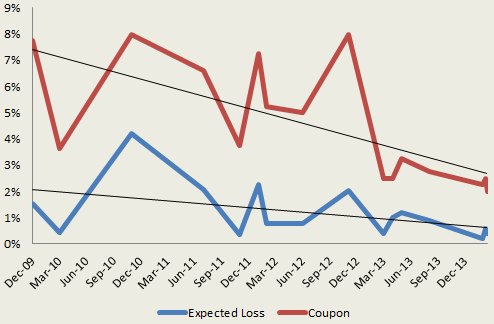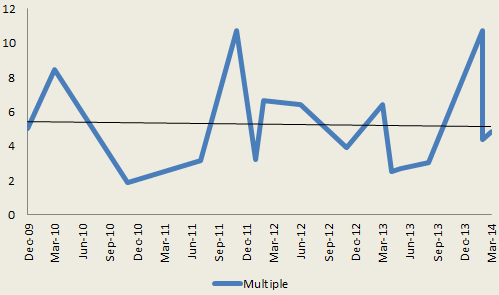In recent days the lowest yielding earthquake catastrophe bonds in the ILS markets history have priced, with U.S. primary insurer State Farm’s $300m Merna Re V Ltd. U.S. earthquake cat bond offering the lowest coupon ever seen for a pure quake bond.
Merna Re V Ltd. reached final pricing on Tuesday, Artemis understands, with the coupon settling at the 2% that it had been lowered to in final marketing. The cat bond launched with price guidance of 2% to 2.5%, which was subsequently lowered to the 2% where it priced.
Merna Re V priced a full 20% lower than State Farm’s previous deal, Merna Re IV Ltd. which completed a year earlier with a coupon of 2.5%. The two transactions have virtually identical levels of risk, in terms of attachment probability and expected losses, making them one of the best comparisons to demonstrate the decline in cat bond rates seen in the market lately.
Another recent earthquake cat bond, Tokio Marine & Nichido Fire’s latest transaction Kizuna Re II Ltd., completed with the lowest Japanese quake cat bond coupon ever seen at 2.25%. Interestingly though, one tranche of this cat bond features one of the highest multiples of expected loss to coupon Artemis has seen, perhaps showing that the market has reached a pricing floor.
In light of these two transactions, Artemis felt it would be worth taking a look at how the trend in declining catastrophe bond rates has played out for pure earthquake cat bonds. We looked at 16 tranches of pure cat bond notes, all issued since December 2009, to see how pricing of these quake cat bonds have moved over time and whether the deals expected losses have also moved.
Earthquake catastrophe bond coupons and expected losses
This first chart shows the 16 earthquake cat bond issuances coupons and expected losses. As would be expected when looking at catastrophe bond issues over time in recent years, the available coupons to investors have declined sharply. Interestingly the expected losses of pure earthquake catastrophe bond issuance over recent years has also declined, although not as rapidly.

Earthquake catastrophe bond coupons and expected losses
The effect of both trends declining at differing speeds, is that the spread between expected loss and coupon has narrowed, suggesting investors are earning less in real terms for assuming the risk now. That is typical of all perils in the catastrophe bond market when reviewing trends over time, as the investor community takes on more risk as it has become more comfortable with the asset class and recognised its low cost-of-capital.
The market for earthquake cat bonds has, of course, been exposed to the declining rates seen across ILS, cat bonds and catastrophe reinsurance. The chart shows that sponsors have more interest in transferring risks at lower expected loss levels into the cat bond market currently, where quake risk is concerned. There may also be an element of investor demand helping to drive issuance here, as investors work out their own appetite for risk as well.
Earthquake catastrophe bond multiples
As well as looking at the pricing of earthquake cat bonds it’s also worth looking at the multiple, of expected loss to coupon payment. The multiple represents a reasonable metric for the amount of risk being assumed by investors, so how much risk for the return. Interestingly, despite the declining coupons and the slower decline in expected losses, the multiple on the same 16 earthquake catastrophe bond issues follows a relatively level trend.

Earthquake catastrophe bond multiples
The trend line on the chart above shows that there has been a very small decline in multiples on earthquake catastrophe bond deals in recent years, but nothing significant. This suggests that investors have been able to maintain the actual risk adjusted return earned on quake cat bonds, despite the lower coupons and expected losses.
Compared to the broader cat bond market, earthquake risk attracts a higher multiple generally, seemingly sitting just over 5% on average, according to Artemis’ data. The average multiple of the 16 tranches of earthquake cat bonds is 5.26, which is significantly higher than the average multiple at market of all cat bonds, of around 2.2% as we discussed in a recent article here.
This suggests that earthquake catastrophe bonds should be in high demand from investors. The higher multiples, which indicate a better risk adjusted return, should be very attractive given the low multiples on perils such as U.S. wind.
That should be good news for potential sponsors of earthquake cat bonds as it might mean that the multiple will continue to slide gradually, even if coupons are approaching a floor. However the fact that the multiple trend line is relatively level shows that investors know what sort of multiple is required to make earthquake cat bonds an attractive investment proposition.
 View all of our Artemis Live video interviews and subscribe to our podcast.
View all of our Artemis Live video interviews and subscribe to our podcast.
All of our Artemis Live insurance-linked securities (ILS), catastrophe bonds and reinsurance video content and video interviews can be accessed online.
Our Artemis Live podcast can be subscribed to using the typical podcast services providers, including Apple, Google, Spotify and more.































